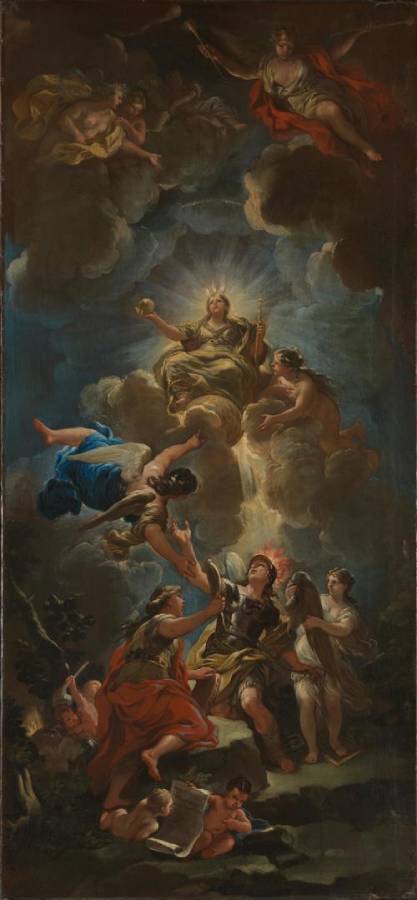Giordano, Luca (1634-1705)
Allegoria della Sapienza Divina (Allegory of Divine Wisdom)
early 1680s
Oil on canvas, 138.5 x 65.2 cm
National Gallery, London
This modello, or detailed oil study, is one of a group of 12 – ten of which are in the National Gallery – that Giordano made in preparation for the ceiling frescoes in the Palazzo Medici Riccardi in Florence in 1682–85. The overall theme of these highly elaborate frescoes is the progress of mankind by means of Wisdom and Virtue.
Eleven of the modelli relate to the spectacular Galleria, a space that housed the family’s precious collection of antiquities and also functioned as a public reception room. This is the only modello that relates to the adjacent Library, another architectural showpiece, the ceiling of which is lit by a semi-circular window high above the ornate bookcases.
Giordano has designed an appropriate allegory for a library. It celebrates the acquisition of knowledge and depicts human intellect as a kneeling warrior – a youth being released from the bonds of ignorance. The rope which bound him hangs loose around his body. Attending him, dressed in a white gown and standing on a set square, is Mathematics – she is giving him wings. In the foreground, Philosophy holds out a mirror that represents self-knowledge; above her, the winged figure of Theology directs the warrior’s gaze up towards the enthroned figure who has become visible through the parting clouds. Holding a globe and sceptre, she represents Divine Wisdom, and the light shining from behind her head illuminates the whole scene. The naked woman to the right of her is Truth.
The subject is based on a line from the poet Petrarch’s Rime (X, line 9). It appears in the fresco, inscribed on the scroll held by putti in the foreground, though slightly misquoted and with a spelling error: ‘LEVAN DI TERRA A CIEL NOSTRO INTEILETTO [sic]’ (‘They raise our mind from earth to heaven’).
Usually assumed to have been painted after the Galleria, the Library fresco was finished by March 1686 at the latest, when Giordano, who was by then back in his native Naples, received a payment of 1000 scudi from the Marquess Francesco Riccardi ‘as the balance for all the works he has done for us and as a present’. Nicodemus Tessin the Younger, a Swedish architect who visited Florence in 1687, records that Giordano had painted the Library fresco in only five days. Giordano was a prolific artist, adept at painting on a large scale and renowned for working at great speed – a skill that earned him the nickname ‘Fa Presto’ (‘does it quickly’). (NG)
Modelli for the Palazzo Medici Riccardi:
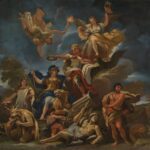 Giordano, Luca (1634-1705)
Giordano, Luca (1634-1705)
Allegoria della Fortezza
early 1680s
National Gallery, London
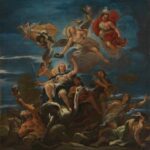 Giordano, Luca (1634-1705)
Giordano, Luca (1634-1705)
Allegoria della Giustizia
early 1680s
National Gallery, London
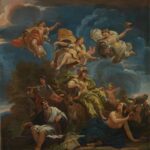 Giordano, Luca (1634-1705)
Giordano, Luca (1634-1705)
Allegoria della Prudenza
early 1680s
National Gallery, London
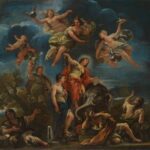 Giordano, Luca (1634-1705)
Giordano, Luca (1634-1705)
Allegoria della Temperanza
early 1680s
National Gallery, London
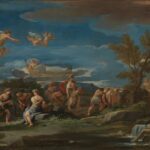 Giordano, Luca (1634-1705)
Giordano, Luca (1634-1705)
Allegoria dell’Agricoltura
early 1680s
National Gallery, London
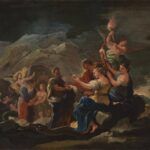 Giordano, Luca (1634-1705)
Giordano, Luca (1634-1705)
Antro dell’eternità
early 1680s
National Gallery, London
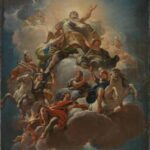 Giordano, Luca (1634-1705)
Giordano, Luca (1634-1705)
Apoteosi dei Medici
early 1680s
National Gallery, London
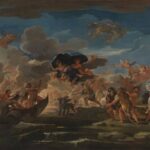 Giordano, Luca (1634-1705)
Giordano, Luca (1634-1705)
La barca di Caronte e il ratto di Proserpina
early 1680s
National Gallery, London
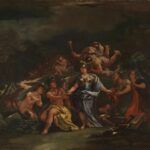 Giordano, Luca (1634-1705)
Giordano, Luca (1634-1705)
Minerva protettrice delle Arti e delle Scienze
early 1680s
National Gallery, London
This group of ten paintings was made by Giordano as a series of detailed oil studies (or modelli) for the ceiling frescoes in the Palazzo Medici Riccardi in Florence, which are among the artist’s finest achievements. The modelli are part of a set of 12 (the other two are in private collections).
Nine of the paintings relate to the ceiling of the highly ornate Galleria, built to house a precious collection of antiquities and function as a public reception room. The other is associated with the ceiling of the adjacent Library. The overall theme in the Galleria is the elevation of mankind through Wisdom and Virtue, using allegorical and mythological figures to represent different strengths and traits. It culminates in a centrepiece which presents the wealthy Medici family as the paradigm of both these qualities.
Giordano seems to have worked up these modelli to clarify his designs and may have presented them to his client, the Marquess Francesco Riccardi, for approval before the frescoes were executed. (NG)
See also:
• Petrarca, Francesco (1304-1374)
